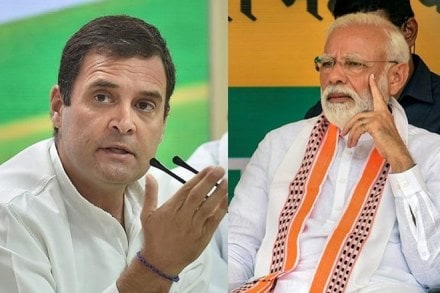Venkata Susmita Biswas
The world of political slogans is a powerful one: it can unite people to rally for a candidate, and, if not well-strategised, can be the undoing of a party’s credibility too. Over the years, Indian political parties have coined some memorable slogans that have infused campaigns with vigour and enthusiasm, giving the public a strong call to action during voting.
Bharatiya Janata Party’s 2014 slogan, Ab Ki Baar Modi Sarkar and the promise of Acche Din have remained etched in the consciousness of the country for five years, being at the centre of political debates on whether the promises were delivered or not. In fact, during the 2016 US presidential elections, then Republican candidate Donald Trump had adopted the 2014 BJP slogan to reach out to the Indian diaspora in the US. Speaking in Hindi, Trump said in a video, ‘Ab Ki Baar Trump Sarkar’.
For the ongoing 2019 general elections, the public preempted BJP’s slogan: Phir Ek Baar Modi Sarkar. People had been using similar words to gauge the possible outcome of the ongoing elections even before the party would announce it as its official slogan, continuing its 2014 narrative.
But the drama doesn’t end here. When Prime Minister Narendra Modi began referring to himself as Chowkidar, Indian National Congress (INC) president Rahul Gandhi attacked him with the Chowkidar Chor Hai slogan in late 2018.
The BJP reacted to the jibe by launching the Main Bhi Chowkidar slogan and song as part of its election campaign. Meanwhile, Congress has led its agenda with Ab Hoga NYAY, with NYAY short form for Nyuntam Aay Yojana (minimum income scheme), an election promise to transfer Rs 72,000 as cash income annually to poorest of the poor.
“Both the leading parties have been very smart and agile about cross-platform promotions, using content very creatively to spread the message,” says Sunchika Pandey, director, brand communications, government and political, Gozoop Online. Parties have gone beyond vanilla digital marketing this year. For example, in addition to the song and slogan, BJP leaders in a coordinated manner added the word Chowkidar to their Twitter handles. Both the BJP and Congress theme songs have made their way to short video platform TikTok, where supporters of either party are posting short videos based on party theme songs.
In the run up to the elections, BJP introduced the Modi Hai toh Mumkin Hai slogan to rally support, but it carries the risk of attack from the opposition party. “This is why a campaign slogan has to be one that cannot be corrupted by the opposition,” says brand consultant Harish Bijoor, founder, Harish Bijoor Consults.
This slogan exposes itself to the same fate that the 2004 BJP slogan ‘India Shining’ suffered. The campaign, which had focused on urban growth and omitted the distress of rural India, was hit severely by Congress’ Aam Aadmi Ko Kya Mila.
“The Congress could have very easily created a montage video of all the things that the BJP government could not achieve to attack the Modi Hai Toh Mumkin Hai campaign,” Bijoor continues. “Ensuring that slogans are invulnerable to attacks by the opposition means that a party must create a slogan that is a statement of change rooted in the campaign promise and not in glorifying the past.”
Pandey says slogans serve their purpose only if they are kept alive by parties. “The 2014 Congress slogan Main Nahin, Hum seems to have been forgotten by the people even though it was a strong one,” she says. Lately, political parties have been working with advertising agencies to create campaign slogans. But this may not necessarily be in the interest of the party, experts say. “Ad agencies have been losing their advisory powers to brands. If a brand does not listen to the advice of an agency, there is little chance that a political party will take an agency’s legitimate advice,” says KV Sridhar, founder and chief creative officer, HyperCollective.
That said, the importance of sloganeering extends to regional parties as well. Mamata Banerjee’s Ma, Mati, Manush introduced during the 2009 general elections became her war cry during the 2011 West Bengal assembly elections and finally, the title of her political poetry book.
The Paanch Saal Kejriwal song by Vishal Dadlani for the 2015 Delhi elections played a pivotal role in popularising Aam Aadmi Party (AAP). A peep into history reveals Lal Bahadur Shastri’s famously coined slogan in 1965, Jai Jawan Jai Kisan, against the backdrop of the war with Pakistan and an imminent food crisis because of a scarcity of food grains. The slogan led the Congress to victory in 1967.
Following the nuclear tests at Pokhran in 1998, former Prime Minister Atal Bihari Vajpayee added Jai Vigyan to the iconic Congress slogan. In January this year, Prime Minister Narendra Modi updated the same slogan to — Jai Jawan, Jai Kisan, Jai Vigyan, Jai Anusandhan. Even though it could be a mouthful now, experts suggest its core message remains the same.
In 1971, Indira Gandhi’s Garibi Hatao (eradicate poverty) resonated with the entire country and helped the Congress secure a landslide victory in the general elections. Poverty was rife after the 1965 war and famine, and the slogan brought ‘hope’ to the masses. With this, Indira Gandhi swiftly turned BJP’s slogan at the time, Indira Hatao, into Garibi Hatao, saying, Woh kehte hain Indira hatao; main kehti hoon garibi hatao.
But catchy slogans and songs can only make an incremental difference to a party’s fate. BJP’s ‘India Shining’ campaign created by Trikaya Grey (now Grey Worldwide), which was memorable possibly for the wrong reasons, “proves that slogans don’t win elections,” says Sridhar of HyperCollective. Slogans catch the imagination of the public only if they are rooted in the party’s values and election mandate. “An overall campaign can help a party go from a slim victory to a winning a majority. Slogans alone cannot turn a loss into a victory,” says Dheeraj Sinha, chief strategy officer, Leo Burnett, India.
